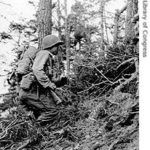By RUSSELL CONTRERAS
Associated Press
ALBUQUERQUE, N.M. (AP) _ As thousands of marchers made their way to the nation’s capital in August 1963 for what was officially billed as the March on Washington for Jobs and Freedom, Maria Varela stayed put in the Deep South with no plans to participate.
Many of her fellow activists in the Student Nonviolent Coordinating Committee felt the march was largely symbolic and would do little to change things, Varela said. She continued her work in Alabama, and eventually moved on to Mississippi.
“A lot of us in SNCC did not support the march at the time,” said Varela, 73, who now lives in Albuquerque. “So we were going to have this huge gathering of people. Then what?”
Latinos were scarce among the 250,000 people who turned out in Washington on Aug. 28, 1963, mainly because they were caught up in pursuing their own causes. Some of the larger Hispanic civil rights organizations even considered publicly denouncing the mass protest. But after seeing the heavily black throngs gathered around the Lincoln Memorial they learned some lessons from that show of political force, historians say.
“They were uncomfortable with marches. But that was about to change,” said Iowa State University history professor Brian Behnken, author of a book on the civil rights struggles of blacks and Mexican Americans in Texas. A big factor in the lack of large-scale Hispanic participation, Behnken said, was that groups such as the League of United Latin American Citizens simply had not quite evolved to such a level of national protest.
“Eventually, a new movement would emerge,” Behnken said. “And new coalitions would form.”
The national march didn’t go entirely unmarked by Hispanics. A coalition of black and Mexican Americans held a companion march on that same day in Austin, Texas, which drew roughly 900 people, according to the Texas State Historical Association. The marchers, including Hispanics, blacks and whites, protested Gov. John Connally’s opposition to civil rights legislation pending in Congress.
Individual Hispanics who did attend the March on Washington “did so out of personal choice,” said Lauren Araiza, history professor at Denison University in Granville, Ohio.
At least two photographs in the Bridgeman Art Library in New York depict Latino presence at the 1963 march. In one photo, photographer Nat Herz captured images of marchers holding aloft Puerto Rican flags as they walked down Constitution Avenue. A second photo shows a man holding aloft a handwritten cardboard sign that said “Mexico Agrees.”
Singer Joan Baez, whose father was originally from Mexico, was joined by Bob Dylan and Len Chandler in performing at the 1963 march.
Raul Yzaguirre, former president of the National Council of La Raza, was a student volunteer at a first aid station on the National Mall. In a 2003 interview with NPR on the march’s 40th anniversary, Yzaguirre said the eloquence of Martin Luther King Jr.’s “I Have a Dream” speech moved him to take his civil rights advocacy beyond Latino causes.
“Although the focus was on the African-American community at that time, I think his thoughts, his sense of justice resonated with those of us who had perhaps a broader sense of inclusion, who wanted Latinos and Native Americans and other minorities to be an integral part of a civil rights movement,” Yzaguirre said.
Certainly, Hispanics in America were experiencing discrimination. Like blacks, Mexican Americans were being subjected to poll taxes in order to vote, and in Texas, some restaurants posted signs that read, “No Dogs, Negroes or Mexicans.”
Latino farm workers in California toiled in the fields for low wages, and Puerto Ricans in New York suffered in substandard housing, sometimes without basic services.
A copy of the original organizing manual for the March on Washington, under the heading “Why We March,” showed that organizers did try to include the plight of Latinos in their statement of purpose for the massive gathering.
“Discrimination in education and apprenticeship training renders Negroes, Puerto Ricans, Mexicans, and other minorities helpless in our mechanized, industrial society,” the manual read. “Lacking specialized training, they are the first victims of automation.”
Varela, one of the few Latino activists to participate in both the black civil rights movement and the Chicano Movement, said the direction of the movement after the march was over was of primary concern. The Chicano movement was a period of activism by Mexican Americans in the late 1960s and early 1970s which focused on the empowerment of that group.
“We were not about developing one charismatic leader to take charge, but instead encouraged many leaders who would be there long after the charismatic leaders were gone,” Varela said. “I was in Alabama at the time, and learned that each region in the South was different in how they went about creating their movements.”
Blacks and Mexican Americans had long been working together on civil rights causes. The NAACP joined with the League of United Latin American Citizens in the 1947 Mendez v. Westminster case in California, which helped lay the groundwork for Brown v. Board of Education, the landmark 1954 Supreme Court decision that struck down segregation in public schools.
Mike Herrera, son of the late Houston civil rights attorney John J. Herrera, said his father wanted to see Latinos organized nationally to press for change, and he was excited by the March on Washington.
“We just didn’t have the numbers yet and we were way out here in Texas where no one paid much attention,” the younger Herrera said.
Others, like Latino farm workers in California, drew greater inspiration from protests such as the voting rights marches in Selma, Ala., Araiza said, because “those were much more grass-roots oriented and something they could relate to.”
Cesar Chavez and Dolores Huerta, co-founders of the United Farm Workers of America, would launch their own marches in California and adopt nonviolent strategies like boycotts and picketing.
King sent Chavez a telegram in 1966, while Chavez was fasting for collective bargaining rights for farmworkers. In the telegram King told Chavez he was moved.
“The plight of your people and ours is so grave,” King said, “that we all desperately need the inspiring example and effective leadership you have given.”
___
Associated Press writer Suzanne Gamboa in Washington contributed to this report.
___
Follow Russell Contreras at http://twitter.com/russcontreras and Suzanne Gamboa at http://www.twitter.com/APsgamboa











